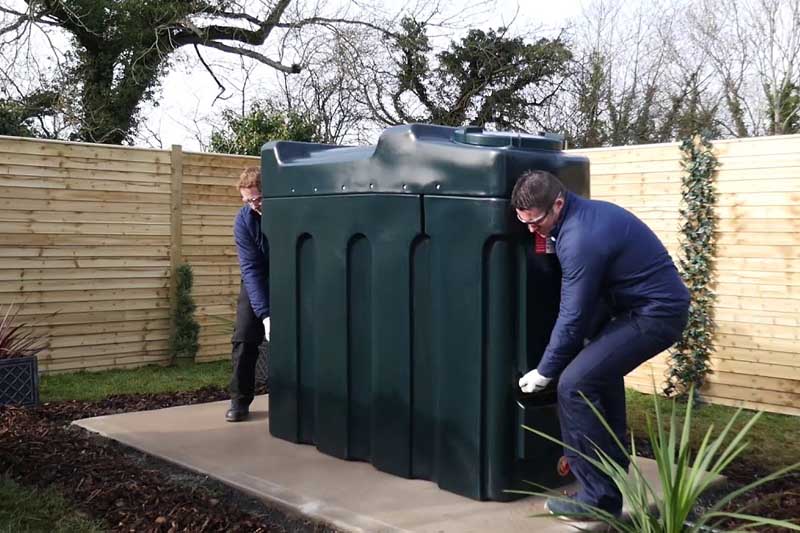To hide an oil tank in your garden effectively, use fences, wooden or metal screens, or garden sheds while ensuring proper ventilation and easy access. You can also disguise it with shrubs, hedges, or artificial rock covers for a natural look. Always maintain safety compliance, leave space for maintenance, and consult experts like 123 Oil to balance aesthetics and functionality.
Oil tanks are an essential part of homes that use heating oil, but they are rarely aesthetically pleasing. A large, metal tank sitting in your garden can disrupt your landscaping and detract from the overall beauty of your outdoor space. Fortunately, there are numerous ways to blend or hide an oil tank effectively while still maintaining safety and accessibility. In this detailed guide, we will explore practical solutions, creative oil tank screening ideas, and tips for disguising an oil tank without compromising its functionality.
Why You Might Want to Hide Your Oil Tank
There are several reasons homeowners consider how to hide an oil tank in the garden:
- Aesthetics: An oil tank can be an eyesore, especially in a beautifully landscaped garden. Screening can enhance the visual appeal of your outdoor space.
- Safety: Hiding the tank behind a screen or fence can also deter tampering, especially in households with children or pets.
- Compliance: In some areas, regulations may require tanks to be shielded from view, particularly if they are close to neighbours or public places.
Safety First: Considerations before Hiding an Oil Tank
Before you start thinking about ways to disguise an oil tank, it’s important to consider safety:
- Access for maintenance: Your oil supplier or engineer needs easy access for deliveries and servicing.
- Ventilation: Proper airflow around the tank prevents the build-up of fumes.
- Fire safety regulations: Any fencing or screening should comply with local fire safety standards and not obstruct safety valves.
It’s important to balance aesthetics with safety and functionality. Consulting your supplier or a professional, 123 Oil, can help ensure your solution is compliant.
Oil Tank Screening Ideas
There are several effective ways to hide or screen your oil tank. Here are some creative oil tank screening ideas:
Fencing and Wooden Screens
One of the simplest and most popular methods is using a wooden fence or lattice screen around your tank. Wooden panels can be painted or stained to match your garden decor.
- Ensure the fence is tall enough to completely hide the tank.
- Leave a gap at the bottom for airflow and drainage.
- Use hinges or removable panels for easy access.
A wooden fence provides a natural look and blends well with plants and hedges.
Planting Hedges and Shrubs
A living screen can be a beautiful way to disguise an oil tank. Fast-growing shrubs, hedges, or bamboo can create a natural barrier.
- Choose plants that are dense enough to hide the tank.
- Leave some space between the tank and the plants to allow for maintenance and ventilation.
- Consider seasonal growth and maintenance needs.
This option combines functionality with aesthetics, enhancing your garden while keeping the tank out of sight.
Decorative Screens and Panels
Decorative metal or composite panels are a modern option for oil tank screening. These panels can feature intricate designs or patterns that complement your garden style.
- Metal panels are durable and weather-resistant.
- Choose panels with cutouts or perforations to maintain airflow.
- Combine with climbing plants for a softer, natural look.
Decorative panels offer a stylish solution while still meeting safety requirements.
Garden Structures and Sheds
If you prefer a more substantial solution, a small garden shed or structure can completely enclose the tank.
- Ensure the structure is non-combustible or uses fire-resistant materials.
- The roof should allow rainwater drainage and prevent water pooling.
- Include lockable doors for security and for easy delivery access.
Sheds not only hide the tank but can also provide additional storage space for gardening tools or outdoor equipment.

Artificial Rock Covers
For a more creative approach, consider an artificial rock cover. These are lightweight structures designed to resemble natural boulders and can blend seamlessly into your garden landscape.
- Place the artificial rock around the tank, ensuring it does not touch the valves or connections.
- They are durable, weather-resistant, and require minimal maintenance.
- Perfect for natural or rustic garden designs.
This option is ideal if you want the tank to be completely invisible without installing permanent structures.
Recycled and Upcycled Ideas
For eco-friendly homeowners, reusing materials like pallets or old fencing panels can create a unique oil tank screen.
- Paint or stain the materials to match your garden design.
- Combine with climbing plants or hanging baskets to soften the look.
- Ensure the structure is sturdy and allows for ventilation.
Recycling materials can be budget-friendly while adding a creative touch to your garden.
Tips on How to Disguise an Oil Tank Effectively
When planning ways to hide an oil tank, keep the following tips in mind:
- Maintain Accessibility: Any screening solution should allow for easy access for oil deliveries and maintenance.
- Ensure Proper Ventilation: Avoid fully enclosing the tank without airflow; trapped fumes can pose a safety risk.
- Follow Regulations: Check local building codes and fire safety regulations to ensure your screening solution complies with them.
- Consider Aesthetics: Choose materials and designs that complement your garden style, whether modern, rustic, or traditional.
- Think About Maintenance: Screens or structures should be easy to clean and maintain. Wood may need periodic staining, while metal may require rust prevention.
Combination Ideas to Hide Oil Tanks in the Garden
For the best results, homeowners often use a combination of solutions:
- Fence with Climbing Plants: Provides privacy, aesthetics, and airflow.
- Garden Shed with Decorative Panels: Complete enclosure with stylish detailing.
- Artificial Rock with Shrubs: Natural look with minimal maintenance.
Combining elements allows you to blend the oil tank into your garden design while keeping it functional and accessible.
Common Mistakes to Avoid
Even with the best intentions, some mistakes can compromise safety or effectiveness:
Placing plants too close to the tank can block airflow or damage the tank during growth.
- Using flammable materials: Wooden fences or sheds should be treated for fire resistance.
- Obstructing valve access: Always leave room for emergency shut-offs and maintenance.
- Neglecting ventilation: Completely sealed enclosures are dangerous and non-compliant.
Avoiding these errors ensures that your oil tank remains safe while improving the look of your garden.
Final Thoughts
Hiding an oil tank in your garden doesn’t have to be a challenge. With the right approach, you can combine safety, functionality, and aesthetics. Whether you opt for a wooden fence, decorative panels, living hedges, garden sheds, or even artificial rocks, there are countless ways to effectively disguise an oil tank.
Remember, safety should always come first. Ensure that your solution provides proper ventilation, allows for easy maintenance, and complies with fire regulations. Suppliers and experts like 123 Oil can offer guidance and practical solutions for compliant oil tank screening.
By taking the time to implement a well-thought-out solution, you can keep your oil tank out of sight, enhance your garden’s appearance, and maintain a safe environment for your family and property.
Frequently Asked Questions
Yes, with options like sheds, artificial rock covers, or fencing combined with plants, you can fully conceal your tank while maintaining access and safety.
Yes, but leave enough space for ventilation and maintenance. Avoid planting directly against the tank.
Yes, but ensure it is made of non-combustible materials or treated wood, and that it allows proper ventilation.
Installing a wooden or metal screen with climbing plants is a simple and effective method.
It’s recommended to consult professionals like 123 Oil to ensure your solution complies with safety regulations and maintains easy access for deliveries and maintenance.










